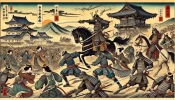Hokkaido in the 20th Century: From War to Modern Tourism and Economic Growth
The 20th century was a period of significant transformation for Hokkaido, Japan’s northernmost island. From the impacts of war and the challenges of post-war reconstruction to the modernization of agriculture and industry, and the emergence of major tourist destinations, Hokkaido underwent profound changes that shaped its contemporary identity. This article delves into these pivotal developments, exploring how Hokkaido evolved through the decades and emerged as a vital part of modern Japan.
Impact of War and Post-War Reconstruction
Hokkaido played a strategic role during World War II due to its geographical location and resources. The island was a critical supply base for the Japanese military, and its ports and airfields were crucial for operations in the northern Pacific. The war brought significant hardships to the local population, including food shortages, forced labor, and air raids. The city of Hakodate, for example, suffered from bombings that destroyed much of its infrastructure.
The end of World War II marked the beginning of a challenging reconstruction period for Hokkaido. The island faced the daunting task of rebuilding its economy and infrastructure amidst a backdrop of widespread devastation. The Japanese government, with support from the Allied forces, initiated various reconstruction efforts aimed at reviving the local economy and improving living conditions. Key projects included rebuilding transportation networks, restoring agricultural production, and reviving industrial activities.
During this period, Hokkaido also experienced significant demographic changes. Many war-displaced people moved to the island, seeking new opportunities and contributing to the labor force required for reconstruction. The influx of new residents brought diverse skills and knowledge, which played a crucial role in the region’s recovery and development.
Development of Agriculture and Industry
Agriculture in Hokkaido saw substantial modernization and mechanization during the 20th century. The introduction of new farming techniques, machinery, and crops transformed the agricultural landscape. Government initiatives, such as land reclamation projects and agricultural subsidies, supported these changes. Hokkaido became known for its large-scale farming operations, particularly in dairy farming, potato cultivation, and rice production.
The growth of key industries such as mining, forestry, and fishing further propelled Hokkaido’s economic development. The island’s rich natural resources, including coal, timber, and fish, were exploited to support Japan’s rapid industrialization. Mining towns like Yubari thrived during the peak of coal production, while forestry operations expanded to meet the demand for timber.
Government policies and initiatives played a crucial role in supporting Hokkaido’s economic development. The establishment of industrial zones, investment in infrastructure, and promotion of regional development programs helped attract businesses and industries to the island. These efforts led to the creation of job opportunities, improved living standards, and increased economic output.
Formation of Major Tourist Destinations
The 20th century also saw Hokkaido emerge as a major tourist destination, renowned for its natural beauty and recreational opportunities. The development of key attractions such as ski resorts, hot springs, and national parks played a pivotal role in promoting tourism.
Ski resorts like Niseko and Furano gained popularity among domestic and international tourists for their excellent snow conditions and modern facilities. These resorts not only attracted winter sports enthusiasts but also contributed to the local economy by generating employment and supporting related businesses such as hotels, restaurants, and retail shops.
Hot springs, or onsen, became another significant draw for tourists. Destinations like Noboribetsu and Jozankei offered relaxing hot spring experiences set against scenic backdrops. These onsen towns developed comprehensive tourism infrastructures, including accommodations, entertainment, and wellness facilities, enhancing their appeal to visitors.
Hokkaido’s national parks, including Shiretoko, Daisetsuzan, and Akan, showcased the island’s diverse natural landscapes, from rugged coastlines and volcanic mountains to pristine forests and lakes. These parks provided opportunities for outdoor activities such as hiking, wildlife viewing, and camping, attracting nature lovers and adventure seekers.
The promotion of tourism by local governments and tourism organizations played a crucial role in establishing Hokkaido as a premier travel destination. Marketing campaigns, improved accessibility through transportation networks, and the development of tourist facilities contributed to the steady growth of the tourism sector.
Conclusion
The 20th century was a transformative era for Hokkaido, marked by significant developments in various sectors. The impacts of war and the challenges of post-war reconstruction shaped the island’s resilience and ability to adapt. The modernization of agriculture and industry fueled economic growth and improved living standards, while the formation of major tourist destinations positioned Hokkaido as a key player in Japan’s tourism industry.
These changes have left a lasting legacy on contemporary Hokkaido, contributing to its vibrant economy, diverse cultural landscape, and status as a popular travel destination. Understanding the historical context of these developments provides valuable insights into the island’s evolution and its role in modern Japan.
For those interested in exploring further details about Hokkaido’s history and development during the 20th century, related articles are available for in-depth reading.
Next:Contemporary Hokkaido: Exploring the Economic Powerhouse and Cultural Gem of Japan’s North









